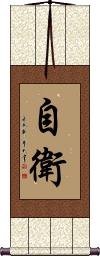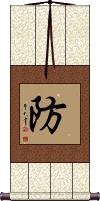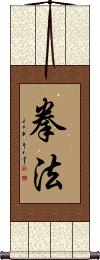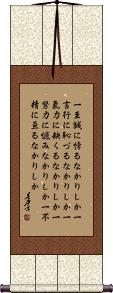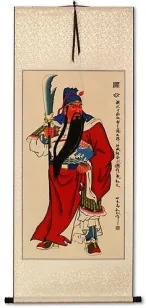Many custom options...
And formats...

Self-Defense in Chinese / Japanese...
Buy a Self-Defense calligraphy wall scroll here!
Personalize your custom “Self-Defense” project by clicking the button next to your favorite “Self-Defense” title below...
Self-Defense
Defense / Defend
防 is a single Chinese character and Korean Hanja that means to protect, defend, guard against, prevent, ward off, or counter.
防 means the same thing in Japanese, though seldom seen alone as a single Kanji. When written alone, it could be the Japanese surname Fusegi.
Kenpo / Kempo / Quan Fa / Chuan Fa
拳法 is a form of martial arts that can be translated in several ways.
Some will call it “fist principles,” “the way of the fist,” or even “law of the fist.” The first character literally means fist. The second can mean law, method, way, principle, or Buddhist teaching.
Kempo is really a potluck of martial arts. Often a combination of Chinese martial arts such as Shaolin Kung Fu with Japanese martial arts such as Karate, Jujutsu (Jujitsu), Aikido, and others. You may see the term “Kempo Karate,” which basically means Karate with other disciplines added. In this way, Kempo becomes an adjective rather than a title or school of martial arts.
These facts will long be argued by various masters and students of Kempo. Even the argument as to whether it should be spelled “kenpo” or “Kempo” ensues at dojos around the world (the correct Romaji should actually be “kenpou” if you precisely follow the rules).
The benefit of Kempo is that the techniques are easier to learn and master than pure Kung Fu (wu shu). Students are often taught basic Karate moves, kicks, and punches before augmenting the basic skills with complex Kung Fu techniques. This allows students of Kempo to achieve a level where they can defend themselves or fight in a relatively short amount of time (a few years rather than a decade or more).
Because the definition of this word is so fluid, I should make some notes here:
1. Purists in Okinawa will claim that “Okinawa Kenpo” or “Ryukyu Hon Kenpo” is the original and true version of this martial art from the old kingdom. It is actually little or no connection between Okinawa Kenpo and the way the word is used elsewhere.
2. In Chinese, where these characters are pronounced “quan fa” (sometimes Romanized as “chuan fa” because the Chinese-pinyin “q” actually sounds like an English “ch” sound), these characters do not hold the connotation of being a mixed martial art. It is simply defined as “the law of the fist.”
3. My Japanese dictionary oddly defines Kenpo as the “Chinese art of self-defense.” I personally don't feel this is the most common way that people perceive the word but just something you should know.
Furinkazan
military strategy
風林火山 is the battle strategy and proverb of Japanese feudal lord Takeda Shingen (1521-1573 AD).
This came from the Art of War by Chinese strategist and tactician Sun Tzu (Sunzi).
You can think of this as an abbreviation to remind officers and troops how to conduct battle.
風林火山 is a word list: Wind, Forest, Fire, Mountain.
The more expanded meaning is supposed to be...
“Swift as the wind, quiet as the forest, fierce as fire, and immovable as a mountain”
“As fast as the wind, as quiet as the forest, as daring as fire, and immovable as the mountain”
“Move as swift as the wind, stay as silent as a forest, attack as fierce as fire, undefeatable defense like a mountain”
“Move swiftly like the wind, stay silent like the forest, attack fiercely like fire, take a tactical position on the mountain”
See Also: Art of War
Life Of A Samurai
The 12th century phrase, 一所懸命 (Issho Kenmei) is often referred to as “Life Of A Samurai.”
Breaking it down:
一 = one
所 = place
懸 = devote
命 = life
一所懸命 literally means “to stake your life on one place.” Today, Japanese people use it to mean giving your full effort to something.
Other translations of 一所懸命 include: Very hard, with utmost effort, as hard as one can, with all one's might, for dear life, eagerly, and/or desperately.
In the context of the Samurai, it is devoting oneself to the defense of one's territory.
Originally 一生懸命 meaning “to stake your life on one birth.”
Five Reflections / Gosei
ki ryo ku ni ka ku ru na ka ri shi ka? do ryo ku ni u ra mi na ka ri shi ka?
bu sho u ni wa ta ru na ka ri shi ka?
These are the “Five Reflections” of Vice Admiral Hajime Matsushita of the Japanese Imperial Navy.
These days, the Five Reflections are recited or contemplated daily by Japan Maritime Self-Defense Force recruits in training. This long proverb is popularly translated into English this way:
Hast thou not gone against sincerity?
Hast thou not felt ashamed of thy words and deeds?
Hast thou not lacked vigor?
Hast thou not exerted all possible efforts?
Hast thou not become slothful?
Note: Because this selection contains some special Japanese Hiragana characters, it should be written by a Japanese calligrapher.
Taekwondo
跆拳道 is one of the most widespread types of martial arts in the world as well as being an Olympic sport. Taekwondo was born in Korea with influences of Chinese and Japanese styles combined with traditional Korean combat skills. Some will define it as the “Korean art of empty-handed self-defense.”
In the simplest translation, the first character means “kick,” the second character can mean either “fist” or “punching,” and the third means “way” or “method.” Altogether, you could say this is the “Kick Punch Method.” When heard or read in various Asian languages, all will automatically think of this famous Korean martial art. It is written the same in Japanese Kanji, Chinese, and Korean Hanja characters - so the appearance of the characters is universal. However, you should note that there is another way to write this in modern Korean Hangul characters, which looks like the image to the right. 
We suggest the original Korean Hanja (Chinese characters) for a wall scroll, but if you need the Hangul version, you must use master calligrapher Cao Bin: Order Taekwondo in Korean Hangul
Note: Taekwondo is sometimes Romanized as Tae-Kwondo, Tae Kwon Do, Taekwon-do, Taegwondo, Tae Gweon Do, Tai Kwon Do, Taikwondo, Taekwando, Tae Kwan Do and in Chinese Taiquandao, Tai Quan Dao, Taichuando, or Tai Chuan Tao.
This in-stock artwork might be what you are looking for, and ships right away...
Not the results for self-defense that you were looking for?
Below are some entries from our dictionary that may match your self-defense search...
| Characters If shown, 2nd row is Simp. Chinese |
Pronunciation Romanization |
Simple Dictionary Definition |
武術 武术 see styles |
wǔ shù wu3 shu4 wu shu bujutsu ぶじゅつ |
More info & calligraphy: Martial Arts / Wushu(1) martial arts; military arts; (2) (See 武術太極拳) wushu (Chinese martial art) |
自衛 自卫 see styles |
zì wèi zi4 wei4 tzu wei jiei / jie じえい |
More info & calligraphy: Self-Defense(n,vs,vt,vi,adj-no) self-defense; self-defence |
護身術 see styles |
goshinjutsu ごしんじゅつ |
More info & calligraphy: Goshin Jutsu |
J隊 see styles |
jeitai / jetai ジェイたい |
(slang) (See 自衛隊・1) Japan Self-Defense Forces; JSDF |
守刀 see styles |
mamorigatana まもりがたな |
(irregular okurigana usage) sword for self-defense; sword for self-defence |
海自 see styles |
kaiji かいじ |
(abbreviation) (See 海上自衛隊) Maritime Self-Defense Force |
空佐 see styles |
kuusa / kusa くうさ |
(Self Defense Force's Air Force) colonel (defence); lieutenant; major |
空将 see styles |
kuushou / kusho くうしょう |
(Self Defense Force's Air Force) general (defence); lieutenant; major |
空尉 see styles |
kuui / kui くうい |
(Self Defense Force's Air Force) captain (defence); lieutenant |
空曹 see styles |
kuusou / kuso くうそう |
noncommissioned officer of the Japanese Air Self Defense Forces (Defence) |
空自 see styles |
kuuji / kuji くうじ |
(abbreviation) (See 航空自衛隊・こうくうじえいたい) Air Self-Defense Force; ASDF; (o) Air Self-Defense Force (abbreviation); ASDF |
自保 see styles |
zì bǎo zi4 bao3 tzu pao |
to defend oneself; self-defense; self-preservation |
陸自 see styles |
rikuji りくじ |
(abbreviation) (See 陸上自衛隊) Japan Ground Self-Defense Force; JGSDF |
守り刀 see styles |
mamorigatana まもりがたな |
sword for self-defense; sword for self-defence |
普通科 see styles |
futsuuka / futsuka ふつうか |
(1) infantry (in the Japan Ground Self-Defense Force); (2) (See 普通課程) general education curriculum |
自衛団 see styles |
jieidan / jiedan じえいだん |
(1) self defense group; self defence group; (2) self-protection |
自衛官 see styles |
jieikan / jiekan じえいかん |
Japanese Self-Defense Force official; Self-Defense Force official |
自衛権 see styles |
jieiken / jieken じえいけん |
right of self defense; right of self defence |
自衛艦 see styles |
jieikan / jiekan じえいかん |
Japan Maritime Self-Defense Force ship; Self-Defense Force ship; JMSDF ship |
自衛隊 自卫队 see styles |
zì wèi duì zi4 wei4 dui4 tzu wei tui jieitai / jietai じえいたい |
self-defense force; the Japanese armed forces (1) Japan Self-Defense Forces; JSDF; (2) self-defence force; self-defense force |
護衛艦 护卫舰 see styles |
hù wèi jiàn hu4 wei4 jian4 hu wei chien goeikan / goekan ごえいかん |
escort vessel; frigate; corvette escort vessel; destroyer (Japan Maritime Self-Defense Force) |
護身刀 see styles |
goshintou / goshinto ごしんとう |
(See 守り刀) sword used for self-defense |
護身用 see styles |
goshinyou / goshinyo ごしんよう |
(adj-no,n) (for) self-defense; (for) self-protection |
正当防衛 see styles |
seitoubouei / setoboe せいとうぼうえい |
(yoji) {law} legitimate self-defence; legitimate self-defense |
正當防衛 正当防卫 see styles |
zhèng dàng fáng wèi zheng4 dang4 fang2 wei4 cheng tang fang wei |
reasonable self-defense; legitimate defense |
海外派遣 see styles |
kaigaihaken かいがいはけん |
overseas dispatch (e.g. of the Japan Self-Defense Forces) |
自己防衛 see styles |
jikobouei / jikoboe じこぼうえい |
self-defense |
自我防衛 自我防卫 see styles |
zì wǒ fáng wèi zi4 wo3 fang2 wei4 tzu wo fang wei |
self-defense |
自衛手段 see styles |
jieishudan / jieshudan じえいしゅだん |
(noun/participle) measures to defend oneself (for self-defense) (defence) |
自衛艦隊 see styles |
jieikantai / jiekantai じえいかんたい |
(org) Self-Defense Fleet; (o) Self-Defense Fleet |
Click here for more self-defense results from our dictionary
The following table may be helpful for those studying Chinese or Japanese...
| Title | Characters | Romaji (Romanized Japanese) | Various forms of Romanized Chinese | |
| Self-Defense | 自衛 自卫 | ji ei / jiei | zì wèi / zi4 wei4 / zi wei / ziwei | tzu wei / tzuwei |
| Defense Defend | 防 | bou / bo | fáng / fang2 / fang | |
| Kenpo Kempo Quan Fa Chuan Fa | 拳法 | kenpou / kenpo | quán fǎ / quan2 fa3 / quan fa / quanfa | ch`üan fa / chüanfa / chüan fa |
| Furinkazan | 風林火山 风林火山 | fuu rin ka zan fuurinkazan fu rin ka zan | fēng lín huǒ shān feng1 lin2 huo3 shan1 feng lin huo shan fenglinhuoshan | |
| Life Of A Samurai | 一所懸命 | issho kenmei isshokenmei isho kenmei | ||
| Five Reflections Gosei | 一至誠に悖るなかりしか一言行に恥づるなかりしか一氣力に缺くるなかりしか一努力に憾みなかりしか一不精に亘るなかりしか | shi se i ni moto ru na ka ri shi ka? gen kou ni ha zu ru na ka ri shi ka? ki ryo ku ni ka ku ru na ka ri shi ka? do ryo ku ni u ra mi na ka ri shi ka? bu sho u ni wa ta ru na ka ri shi ka? shi se i ni moto ru na ka ri shi ka? gen ko ni ha zu ru na ka ri shi ka? ki ryo ku ni ka ku ru na ka ri shi ka? do ryo ku ni u ra mi na ka ri shi ka? bu sho u ni wa ta ru na ka ri shi ka? | ||
| Taekwondo | 跆拳道 | te kon do / tekondo | tái quán dào tai2 quan2 dao4 tai quan dao taiquandao | t`ai ch`üan tao taichüantao tai chüan tao |
| In some entries above you will see that characters have different versions above and below a line. In these cases, the characters above the line are Traditional Chinese, while the ones below are Simplified Chinese. | ||||
Successful Chinese Character and Japanese Kanji calligraphy searches within the last few hours...
